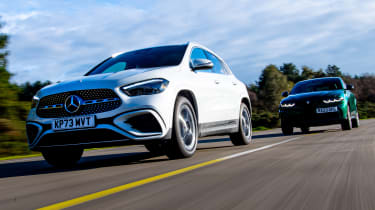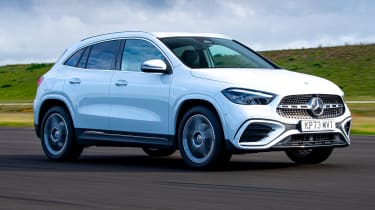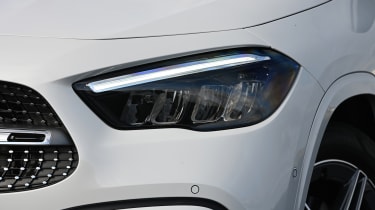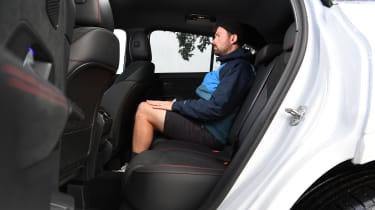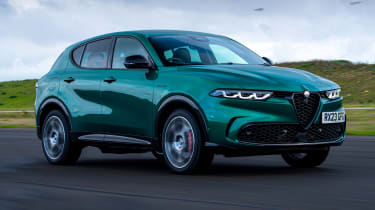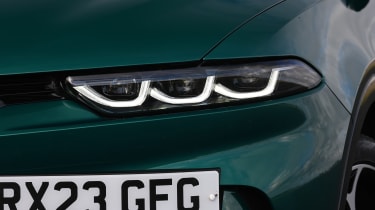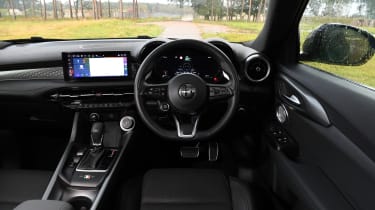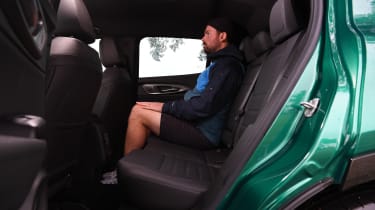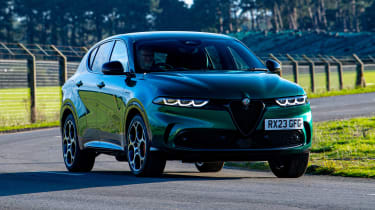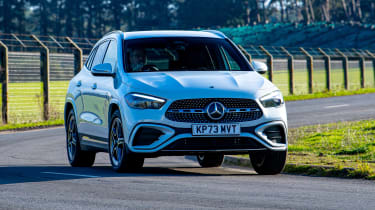Mercedes GLA vs Alfa Romeo Tonale 2024 twin test: premium plug-in hybrids go head-to-head
Updates to the Mercedes GLA include a longer range for the plug-in hybrid version – does that put it ahead of the Alfa Romeo Tonale?
Premium plug-in hybrid SUVs come in all shapes and sizes, with car makers tapping into demand from buyers who want to reduce their fuel bills and emissions, but don’t want to go all the way and drive an electric car.
At the compact end of the market, the Mercedes GLA has evolved from what was little more than a high-riding hatchback into a more family-friendly machine, and the second-generation model was boosted by the addition of the GLE 250 e PHEV. An update to the line-up in 2023 saw the GLA benefit from the same range of tech additions as seen in the A-Class hatch, while the 250 e version was given a bigger battery, a more powerful electric motor and more charging options.
Does that help the GLA remain as one of our favourite small premium SUVs? To find out, we’ve lined it up against the Alfa Romeo Tonale. The Italian SUV also comes with an efficient plug-in powertrain, but offers a sportier edge than the Mercedes. Is that enough for it to take victory over its German rival?
| Mercedes GLA 250 e AMG Line Premium | Alfa Romeo Tonale 1.3 PHEV Q4 Veloce | |
| Price: | £46,820 | £48,495 |
| Powertrain: | 1.3-litre 4cyl turbo petrol/e-motor/16kWh battery | 1.3-litre 4cyl turbo petrol/e-motor/15.5kWh battery |
| 0-62mph: | 7.9 seconds | 6.2 seconds |
| Test efficiency: | 38.7mpg/8.5mpl | 35.3mpg/7.8mpl |
| CO2: | 26g/km | 30g/km |
| Electric range: | 48 miles | 38.5 miles |
Mercedes GLA
The second-generation Mercedes GLA was launched in 2019, while revisions in 2023 introduced a subtle exterior update and fresh on-board tech, including a new version of the MBUX infotainment system.
Tech highlights
The revisions to the GLA are the same as those found across every small Mercedes – the A-Class, B-Class, CLA and GLB – all of which are based on the company’s MFA2 platform. Blink and you’ll miss the reprofiled nose, while the MBUX updates will only be obvious to existing GLA owners. It’s a similar story for the plug-in powertrain, where small upgrades have been made to improve overall efficiency.
The system’s combined power output remains unchanged at 215bhp, but the electric motor now has 107bhp (an increase of 7bhp), while the battery’s efficiency has been boosted, so more of its 16kWh capacity can be used to deliver a WLTP-tested range of up to 48 miles.
There are faster charging options available, too. As well as the standard 3.7kW rate that’s been carried over from the pre-facelift model, the GLA now offers 11kW three-phase AC capability, so the battery can be fully recharged in an hour and a quarter.
The GLA 250 e comes with an eight-speed twin-clutch automatic gearbox, while drive is sent to the front wheels only.
Safety: A five-star Euro NCAP rating was awarded to the GLA when it arrived in 2019, with scores in the 90 per cent range for adult and child occupant protection. Standard safety kit is generous for all models, although only AMG Line Premium and Plus models feature blind-spot detection – it’s not even offered as an option on the rest of the range.
On the road
Overall the GLA is a more comfortable car han its Tonale rival, with a smooth ride and good refinement at all speeds.
Around town: Mercedes has boosted the electric range of the plug-in GLA, so if you do lots of short, local journeys, you might not even have to rely on the petrol engine. The car’s performance around town is refined and responsive in electric mode, and when the engine does fire up, it does so smoothly and without much noise.
Less impressive is the car’s behaviour under braking. Mercedes’ mild-hybrid models can be a little unsettled when transferring between energy recovery and the physical discs and pads, making it difficult to be smooth on the pedal, and this is accentuated in the plug-in model.
At least the low-speed ride is comfortable on the whole. True, the ride is on the firm side, but the damping doesn’t crash when you hit bumps in the road, a characteristic that will be helped by the relatively high profile of the tyre sidewalls.
A & B-roads: Electric drive is used as much as possible at higher speeds, so the GLA is still quite refined. The battery never goes completely flat, either, because the car’s electronics manage energy flow between the engine, motor and wheels once the charge falls below a certain level. The engine cuts in smoothly, so the cabin remains settled.
The GLA isn’t much fun to drive, courtesy of a lack of steering feel and a relatively high centre of gravity that discourages enthusiastic driving. Grip is good, though, so it’s stable and sure-footed.
Motorway: The GLA can drive in EV mode at the national limit, but the car is refined irrespective of the power source that’s being used.
Ownership
One thing that remains unchanged despite the GLA’s facelift is a dashboard layout that’s carried over virtually wholesale from the A-Class. It has the same pair of 10.25-inch displays, a row of three circular air vents below that, plus a bank of climate control keys beneath. The only real giveaways that you’re in the GLA are a taller dashtop and a more upright driving position; even the transmission tunnel dividing the front seats looks identical.
We’re not complaining about the similarities, though, because the quality on board is among the best you’ll find in the small car sector. There are lots of soft-touch materials and the metal switchgear is satisfying to use, especially when you hear and feel the click of the rotary controls on those metal air vents.
The chunky steering wheel is good to hold, but the twin horizontal spokes that are packed with multifunction controls are a bit fiddlier to use than necessary, and need a delicate touch to operate properly. It’s also easy to brush them accidentally when turning the wheel.
Storage: The GLA has decent space in the cabin for odds and ends, with a deep bin beneath the central climate controls that has a wireless smartphone charging pad on AMG Line models. Further back there’s another equally deep bin with charging sockets beneath the centre armrest.
The tray located between these two bins is shallow and narrow, so isn’t really suited to holding very much at all, while the glovebox only takes up half the space behind the door. The front door bins are generous, though.
Aftersales: Both cars here come with a three-year, unlimited-mileage warranty, while Mercedes offers up to 30 years of European breakdown cover, as long as the original owner of the GLA gets it serviced on time at a Mercedes franchise.
Practicality
Upright body offers plenty of useful passenger space, but the boot is compromised by GLA’s plug-in tech,
Rear Space: The cabin feels dark, but headroom is better in the back of the GLA than in the Alfa, while legroom is fine. The cabin isn’t as wide as the Tonale’s, so sitting three across the back is tighter, while the two outer seats are sculpted, but the middle chair is more of a perch. There are two air vents and USB-C sockets in the back, while hard-backed front seats will stand up to kicks.
Boot: The GLA matches the Tonale for capacity in five-seat mode, at 385 litres, but is slightly smaller with the back seats folded, at 1,385 litres. There’s a step in the floor in this configuration, although the 40:20:40 folding does boost versatility. The Mercedes has a lower load lip than the Alfa, too.
What to buy?
Which engine and trim we’d choose
- Powertrains: There’s just one plug-in hybrid system for the GLA, while the GLA 180 and 200 models use the same 1.3-litre petrol engine with mild-hybrid tech. The GLA 200 d and 220 d are the diesels, with the latter being the only version of the GLA with four-wheel drive. All cars are automatic only.
- Trim: The PHEV only comes in AMG Line spec, so its £45,210 starting price is artificially inflated when compared with the petrol range – like for like, it’s around £4,000 more than a GLA 200. That’s for the Executive version, while Premium and Premium Plus options are offered.
- Our choice: AMG Line Executive comes with all of the kit you could possibly want.
Alfa Romeo Tonale
The Tonale is currently Alfa Romeo’s smallest model, and is designed to open up the marque to a new market. The top-spec Veloce model in plug-in hybrid form costs £48,495, although the options fitted to our test car bump the price up to £52,945.
Tech highlights
While the Tonale is a relatively new car for Alfa Romeo, its underpinnings can be traced back to the company’s pre-Stellantis years. In fact, its roots go as far back as the Fiat Grande Punto, but it has evolved a great deal over the years, so much so that the Tonale’s platform has grown to make space on board for a plug-in hybrid powertrain.
Like the Mercedes, the Alfa uses a 1.3-litre four-cylinder turbocharged unit, but it’s more powerful at 178bhp. The electric motor’s output is higher, too, at 121bhp, while a combined total of 276bhp is 61bhp ahead of the GLA’s. What’s more, the Tonale’s system is four-wheel drive, because electric power is sent to both axles. A six-speed twin-clutch automatic gearbox features.
Modern Alfas come with a DNA switch, which is just the company’s branding for its drive mode selector. Here the different settings are named Dynamic, Natural and Advanced Efficiency, with the latter being the Tonale’s all-electric driving mode. Unlike the Mercedes – which has Eco, Comfort, Sport and Individual modes – there’s no function in the Alfa that allows you to personalise the settings to your own liking.
Safety: As with the Mercedes, the Alfa Romeo earned a five-star Euro NCAP crash safety rating, but its results were published in 2022, so its lower percentage scores (bar an 85 per cent rating for its assistance systems) aren’t necessarily comparable with the GLA’s.
On the road
Alfa set out to give the Tonale a sporty edge, and it certainly feels livelier than the Mercedes here.
Around town: There’s a firm edge to the Tonale’s ride, because while this top-spec Veloce model is fitted with 19-inch alloys like the Mercedes, they’re wrapped in lower-profile tyres. It’s not uncomfortable, though, and helps accentuate the Alfa’s sporty feel.
The hybrid system is eager to switch to electric running to boost cabin comfort, which is good, because when the engine does cut in, there’s a bit of a drone from it while cruising at lower speeds in high gears. The Alfa’s braking system is smoother than the GLA’s in Natural mode, with none of the jerkiness experienced in its German rival, but it can become grabby when Dynamic is selected.
A & B-roads: The sharp braking is in keeping with the Tonale’s sporty character, so is less of an issue at higher speeds, while throttle response is quick in Dynamic mode. Some might find it a bit too snatchy, but switching back to the Natural setting makes the car feel sluggish in comparison.
A fast steering rack offers quick changes of direction, while Veloce models feature adaptive dampers that help the Tonale to feel as agile as the lighter Mercedes in corners.
Motorway: It’s at the national limit where differences lie between these two cars. The Alfa’s engine is running for most of the time on the motorway, and because it only has a six-speed gearbox as opposed to the Mercedes’ eight-speed unit, it carries higher revs at 70mph, which has an obvious impact on fuel economy. Thanks to its lower-profile tyres, the Tonale suffers from more road noise than the GLA, too.
The Tonale is currently Alfa Romeo’s smallest model, and is designed to open up the marque to a new market. The top-spec Veloce model in plug-in hybrid form costs £48,495, although the options fitted to our test car bump the price up to £52,945.
Ownership
An Alfa Romeo wouldn’t be an Alfa Romeo without some quirks to its cabin, and while the days of genuinely oddball ergonomics have long gone, the Tonale still manages to offer pleasing and baffling design quirks in equal measure.
Take the steering wheel, for example. It hasa relatively thin rim when compared with the GLA’s wheel, while chunky sections add a sporty feel. Behind that are a pair of large shift paddles that would look more at home in a GT3 car than a compact SUV.
They’re easy to grab when you have applied some lock, and their painted metal finish feels good, but they’re likely to be left untouched by most drivers as they let the automatic transmission do the work. Even worse, they’re so big that they get in the way of the column stalks, meaning you have to reach around the paddles to get to the wipers or indicators. At least there are physical climate controls, while the centre column is neatly arranged around the drive selector.
While some of the cabin quirks might put some buyers off, those that have taken the plunge with an Alfa Romeo have come away impressed, if our Driver Power ownership survey is anything to go by. The manufacturer finished fifth in our most recent poll of 32 makes, well ahead of Mercedes in 25th.
Storage: There are a pair of open cup-holders and a wireless phone charging tray on the Tonale’s centre console, but the only closed storage is beneath the central armrest between the front seats, and it’s not as deep as the GLA’s central bin. The Alfa’s door bins aren’t as deep, either, but the glovebox is a good size. One handy feature is that the Tonale has both USB-A and USB-C sockets on the centre console, so older devices can be connected without issue.
Practicality
Tonale and GLA are level pegging for boot space, but Alfa edges slightly ahead when it comes to carrying passengers.
Rear Space: Access to the back seats could be tricky for taller passengers, because the dip of the roof means the tops of the door frames are low. Both cars offer enough kneeroom in the back, but the Alfa has more foot space, especially if you’re travelling three-up. A flat floor helps, and there’s more room to get your feet under the front seats. There’s more shoulder space on offer, too.
Boot: With a Mercedes-matching capacity of 385 litres, the battle of the boot comes down to the details. There’s less versatile 60:40 seat folding in the Alfa, but when they are dropped, there’s no step in the floor as in the GLA. A powered tailgate is available as part of a £1,700 option pack – it’s standard on the Mercedes.
What to buy?
Which engine and trim we’d choose
- Powertrains: As with the Mercedes, there’s just a single plug-in hybrid drive system offered with the Tonale. It’s one of two powertrains on offer, the other being a 1.5-litre mild hybrid that comes with 148bhp and front-wheel drive.
- Trim: Unlike the GLA, the Tonale’s plug-in powertrain is available across the range, a line-up that comprises three trims in total. Sprint is the entry point to the range, from £35,995, while this Veloce is currently the mid-spec version for £5,000 extra. The current range-topper is the Tributo, which costs another £3,500 on top of that.
- Our choice: This Veloce trim suits the Tonale’s sporty nature and is well specced.
Results
Which car comes out on top?
Winner: Alfa Romeo Tonale
The Tonale was heralded as a new dawn for Alfa Romeo, and it’s certainly the most convincing car that it currently produces. It delivers a sporty drive and it looks the part, while practicality is competitive for the class.
The plug-in model isn’t as efficient as some rivals when the battery is depleted, while some of the quirks of the cabin layout will take some getting used to. But it’s worth persevering, because the Tonale offers character that’s lacking from rivals in the sector.
| Pros | Cons |
| Sharp looks | GLA is more efficient |
| Tidy handling | Some ergonomic quirks |
| Decent rear-seat space | Road noise at higher speeds |
| Competitive finance | Rear visibility |
Runner-up: Mercedes GLA
While the GLA finishes second here, there isn’t really much between it and the Alfa. The GLA’s plug-in powertrain is better resolved in terms of fuel saving than the Tonale’s, while cabin quality and comfort are hard to fault, too.
From behind the wheel the GLA isn’t very memorable. There’s a firm edge to the ride, but without any reward in terms of handling, and vague steering means it lacks involvement – it feels more like an SUV to drive than the Alfa.
| Pros | Cons |
| Efficient plug-in system | Anonymous looks |
| Upmarket cabin quality | Ride is on the firm side |
| Decent boot | Jerky under braking |
| Funky cabin lighting | Fiddly steering wheel controls |
Rivals and other options
The Tonale wins our twin test, but what else is out there?
- Same class: BMW X1
- Same money: Range Rover Evoque
- Used: Porsche Cayenne
- Used: Lexus NX 450h+
- Coming soon: Cupra Terramar
The great debate
What the Auto Express test team would do…
John Mcllroy, editor–at–large: “As we’ve seen with so many PHEVs, if you don’t keep the battery charged up, real-world fuel economy takes a beating. The weight of the discharged electrical system combined with a small engine that’s being made to do all the work truly is the worst of both worlds.”
Richard Ingram, deputy editor: “Keeping a PHEV charged unlocks the best efficiency, but if you don’t have access to a socket where you park your car, you’re stuck. A conventional hybrid would be a better option here. Official economy for the Tonale hybrid is more than 10mpg up on what we achieved in the PHEV on test.”
Dawn Grant, picture editor: “I ran the Tonale in this test on a long-term basis, and was impressed by the matrix lighting during the dark winter months. Not only do the light units look sharp, but they deliver a bright beam where you need it, which is especially useful when you’re negotiating dark country lanes.”
Steve Fowler, editor-in-chief: “The GLA offers much more space than the previous-generation model, but if you need even more room, then there’s the GLB. It doesn’t come as a PHEV, but there are efficient diesels available, while an optional third row of seats adds another level of practicality to the mix.”
Alex Ingram, chief reviewer: “The Tonale is the latest in a long line of Alfa Romeos that is great to look at, and better than most of the competition to drive, yet is let down by a few key flaws. There are still more talented options available, but it’s the one I actually want more than the alternatives.”
Which would you buy? Let us know in the comments section below…
Specs and prices
| Mercedes GLA 250 e AMG Line Premium | Alfa Romeo Tonale 1.3 PHEV Q4 Veloce | |
| On the road price/total as tested | £46,820/ £46,820 | £ 48,495 / £ 52,945 |
| Residual value (after 3yrs/36,000) | £24,861 (53.1%) | £ 24,102 (49.7%) |
| Depreciation | £21,959 | £24,393 |
| Annual tax liability std/higher rate | £748/ £1,496 | £775/ £ 1,550 |
| Annual fuel. cost (10k/20k miles) | £1,993/ £3,322 | £2,185/ £ 3,642 |
| Ins. group/quote/VED | **/£921/ £560 | 38/ £926/ £560 |
| Cost of 1st/2nd/3rd service | £35pm (3yrs) | ***/***/*** |
| Length/wheelbase | 4,436/2,729mm | 4,528/2,636mm |
| Height/width | 1,605/1,849mm | 1,612/1,841mm |
| Powertrain | 4cyl in-line/1,332cc | 4cyl in-line/1,332cc |
| Power/ torque | 161bhp/270Nm | 178bhp/**Nm |
| Electric motor power/torque | 108bhp/300Nm | 121bhp/250Nm |
| Combined power/torque | 215bhp/450Nm | 276bhp/270Nm |
| Transmission | 8spd auto/fwd | 6spd auto/4WD |
| Fuel tank/battery capacity | 35 litres/ 16kWh | 43 litres/ 15.5kWh |
| Boot capacity (seats up / down) | 385/1,385 litres | 385/1,430 litres |
| Kerbweight/payload/towing weight | 1,800/500/1,800kg | 1,935/560/1,250kg |
| Turning circle/spare wheel | 11.4 metres/repair kit | 11.54 metres/repair kit |
| Basic warranty (miles)/recovery | 3yrs (unlimited)/Up to 30yrs | 3yrs (unlimited)/1yr |
| Driver Power manufacturer position | 25th | 5th |
| Euro NCAP: Adult / child / ped. / assist / stars | 96/90/79/75/5 (2019) | 83/85/67/85/5 (2022) |
| 0-62mph / top speed | 7.9 seconds/130mph | 6.2 seconds/128mph |
| Test economy / range | 38.7/ 298 | 35.3/ 334 |
| WLTP combined (MPG) | 256.8mpg | 271.3mpg |
| WLTP combined (MPL) | 56.5mpl | 47.8mpl |
| Pure-electric range (WLTP) | 48 miles | 38.5 miles |
| Charging time (7.4kW AC) | 3h 45 min | 2h 30 min |
| Actual/claimed CO2/tax bracket | 169/26g/km/8% | 185/ 30g/km/ 8% |
| Number of airbags / Isofix points | Nine/two | Seven/two |
| Parking sensors/camera | Front & rear/yes | Front & rear/yes |
| Lane-keep assist / blindspot / AEB | Yes/yes/yes | Yes/yes/yes |
| Climate control/adaptive cruise ctrl | Two-zone/£1,495 | Two-zone/yes |
| Leather / heated seats / wheel | Man-made/yes/no | Yes/yes/yes |
| Metallic paint/LED lights | £625/yes | £700/yes |
| Keyless entry & go/powered tailgate | Yes/yes | Yes/£1,700 pack |
| Sat-nav/digital dashboard/USBs | Yes/yes/five | Yes/yes/three |
| Online services/wireless charging | Yes/yes | Yes/yes |
| Apple CarPlay/Android Auto | Yes/yes | Yes/yes |

